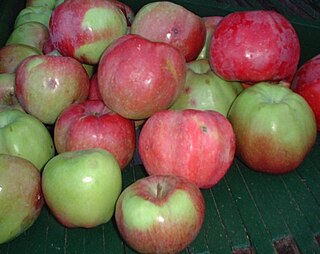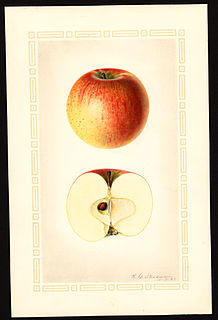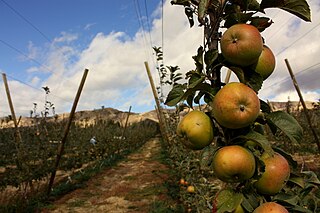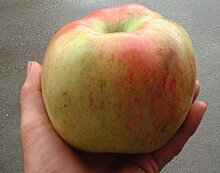
The McIntosh, McIntosh Red, or colloquially the Mac, is an apple cultivar, the national apple of Canada. The fruit has red and green skin, a tart flavour, and tender white flesh, which ripens in late September. In the 20th century it was the most popular cultivar in Eastern Canada and New England, and is considered an all-purpose apple, suitable both for cooking and eating raw. Apple Inc. employee Jef Raskin named the Macintosh computer line after the fruit. John McIntosh discovered the original McIntosh sapling on his Dundela farm in Upper Canada in 1811. He and his wife cultivated it, and the family started grafting the tree and selling the fruit in 1835. In 1870, it entered commercial production, and became common in northeastern North America after 1900. While still important in production, the fruit's popularity fell in the early 21st century in the face of competition from varieties such as the Gala. According to the US Apple Association website it is one of the fifteen most popular apple cultivars in the United States. A mutant(sport) of McIntosh is McIntosh Rogers, synonyms: Red Mc Intosh, Double Red Mc Intosh. This mutant was found in Dansville, New York, USA in 1930.

Fruit tree propagation is usually carried out vegetatively (non-sexually) by grafting or budding a desired variety onto a suitable rootstock.

Malus is a genus of about 30–55 species of small deciduous trees or shrubs in the family Rosaceae, including the domesticated orchard apple, crab apples, wild apples, and rainberries.

Pollination of fruit trees is required to produce seeds with surrounding fruit. It is the process of moving pollen from the anther to the stigma, either in the same flower or in another flower. Some tree species, including many fruit trees, do not produce fruit from self-pollination, so pollinizer trees are planted in orchards.

Cider apples are a group of apple cultivars grown for their use in the production of cider. Cider apples are distinguished from "cookers" and "eaters", or dessert apples, by their bitterness or dryness of flavour, qualities which make the fruit unpalatable but can be useful in cidermaking. Some apples are considered to occupy more than one category.

Gravenstein is a triploid apple cultivar that originated in the 17th century or earlier. The fruit has a tart flavor, and it is heavily used as a cooking apple, especially for apple sauce and apple cider. It does not keep well, and it is available only in season. This is in part because neither cold storage, nor regular controlled atmosphere keeps the apples distinctive aroma, but nsapples.com states that "recently however, low oxygen CA storage has shown promise in retaining this harvest-time quality".
A rootstock is part of a plant, often an underground part, from which new above-ground growth can be produced. It could also be described as a stem with a well developed root system, to which a bud from another plant is grafted. It can refer to a rhizome or underground stem. In grafting, it refers to a plant, sometimes just a stump, which already has an established, healthy root system, onto which a cutting or a bud from another plant is grafted. In some cases, such as vines of grapes and other berries, cuttings may be used for rootstocks, the roots being established in nursery conditions before planting them out. The plant part grafted onto the rootstock is usually called the scion. The scion is the plant that has the properties that propagator desires above ground, including the photosynthetic activity and the fruit or decorative properties. The rootstock is selected for its interaction with the soil, providing the roots and the stem to support the new plant, obtaining the necessary soil water and minerals, and resisting the relevant pests and diseases. After a few weeks, the tissues of the two parts will have grown together, eventually forming a single plant. After some years, it may be difficult to detect the site of the graft although the product always contains the components of two genetically different plants.

Antonovka is a group of late-fall or early-winter apple cultivars with a strong acid flavor that have been popular in Russia as well as in Poland and Belarus. The most popular Russian variety is Common Antonovka, from which other cultivars derive. It was developed by pioneer Russian naturalist and plant breeder Ivan V. Michurin at his experimental orchard in the Tambov Oblast and introduced in 1888.

The 'Roxbury Russet' is an apple cultivar, believed to be the oldest apple cultivar bred in the United States, having first been discovered and named in the mid-17th century in the former Town of Roxbury, part of the Massachusetts Bay Colony southwest of Boston. It is known by several other names including 'Boston Russet', 'Putnam Russet', and 'Sylvan Russet'.

The Northern Spy, also called 'Spy' and 'King', is a cultivar of domesticated apple that originated on the farm of Oliver Chapin in East Bloomfield, New York, in about 1840. It is popular in upstate New York.

The Ben Davis, originally trademarked by the Stark Brothers Nursery as the "Black Ben Davis", is an apple cultivar.

The origins of the Rambo apple cultivar are unknown. It may date back to the American colony of New Sweden, when in 1637 Peter Gunnarsson Rambo, a Swedish immigrant, arrived on the Kalmar Nyckel. Swedish natural historian Pehr Kalm, who wrote Travels in North America, 1747–51, took notes of his interview with Mr. Peter Rambo, grandson of Peter Gunnarsson Rambo, recording that the ″original Peter Rambo had brought apple seeds and several other tree and garden seeds with him in a box.″ The first Rambo apple tree was very likely grown from one of these seeds. There is no certainty, however, since the earliest documented mention of the apple variety's origin occurs in William Coxe's A View of the Cultivation of Fruit Trees, and the Management of Orchards and Cider, published in 1817. Coxe wrote only that the Rambo was much cultivated in Delaware, Pennsylvania, and New Jersey and took "its name from the families by whom it was introduced into notice."

Grafting or graftage is a horticultural technique whereby tissues of plants are joined so as to continue their growth together. The upper part of the combined plant is called the scion while the lower part is called the rootstock. The success of this joining requires that the vascular tissues grow together and such joining is called inosculation. The technique is most commonly used in asexual propagation of commercially grown plants for the horticultural and agricultural trades.

The Newtown Pippin, also known as Albemarle Pippin, is an American apple that originated in the late 17th or early 18th century and is still cultivated on a small scale. At one time, there were two very similar apple cultivars known as the 'Yellow Newtown' and 'Green Newtown', one of which perhaps originated as a sport of the other.

Annona mucosa is a species of flowering plant in the custard-apple family, Annonaceae, that is native to tropical South America. It is cultivated for its edible fruits, commonly known as biribá, lemon meringue pie fruit, or wild sugar-apple, throughout the world's tropics and subtropics.

An apple is an edible fruit produced by an apple tree. Apple trees are cultivated worldwide and are the most widely grown species in the genus Malus. The tree originated in Central Asia, where its wild ancestor, Malus sieversii, is still found today. Apples have been grown for thousands of years in Asia and Europe and were brought to North America by European colonists. Apples have religious and mythological significance in many cultures, including Norse, Greek, and European Christian tradition.

'Discovery' is an early season dessert apple cultivar. One of its parents was the 'Worcester Pearmain', with the pollinator thought to possibly be 'Beauty of Bath'.

The 'York Imperial', or 'York', is a cultivar of apple from which a number of other valuable strains and cultivars have arisen, including four sport varieties: Commander York, Ramey York, Red Yorking, and Yorking.

White Transparent is an early-season cultivar of apple which is usually used for cooking due to its sharp taste. It is sometimes said to be the same as 'Yellow Transparent', but 'Yellow Transparent' is sometimes described differently, with fine rather than coarse flesh, and a sub-acid rather than acid flavour. Weight 75 g, density 0.75 g/cc, sugar 10.5%, acid 11 g/litre, vitamin C 15 mg/100g.

The Tolman Sweet is a cultivar of apple with a butter yellow color, with faint russet dots and a "suture line" along one side of the fruit from top to bottom.





















